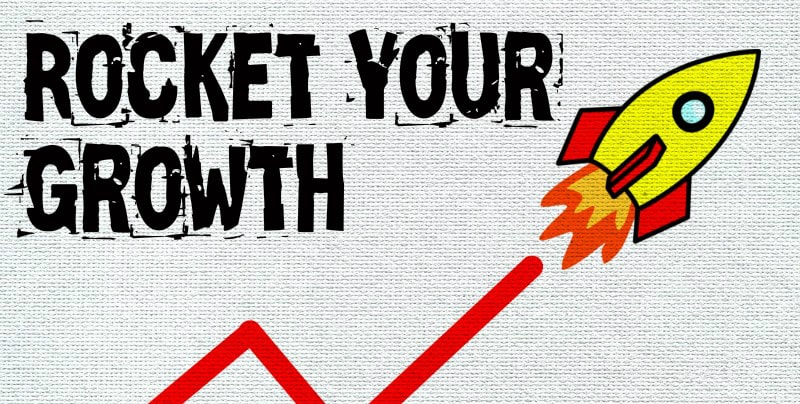I have ONE simple goal for you in this post - and that is that you would remember the following words from Alex Shultz (VP Growth, Facebook.com):
"Retention is the single most important thing for growth"
TL;DR: In this post you will learn:
- Why a 5% increase can lead to an increase profits by 75%
- How a 10% boost in customer retention could literally TRIPLE your customer growth
- Retention Thinking and the Five Customer Retention Strategies for your business
- How Customer Retention affects the Profitability of your business
But, before we get into that, lets answer the most fundamental question: "What exactly is customer retention?"
What do you mean by Customer Retention?
Lets explain the benefits of customer retention to an organisation.
According to Ngdata.com, and
I'm parsing here.. "Customer retention refers to the actions companies and organizations take to reduce the number of customer defections [in order to] to help companies retain as many customers as possible."
According to wikipedia , Customer retention is "the ability of a company [...] to retain its customers", and that "High customer retention means customers [...] tend to return to, continue to buy or in some other way not defect to another product or business, or to non-use entirely. Selling organizations generally attempt to reduce customer defections. "
Notice the words I've bolded.
Customer Retention is the activity of a product or company to reduce the number of customer defections.
DEFINITION: Customer Retention is the activity of a product or company to reduce the number of customer defections.
If you want a simple Customer Retention Formula:
Customer Retention = Reduce Customer Defections
Why does Customer Retention Manter?
According to Inc.com, Customer Retention is a major contributing factor in the net growth rate of businesses.
They cite the example of a company which over the course of a year:
- acquires 20% additional new customers
- but retains only 85 percent of its existing customers
This company will have a Net Customer Growth rate of only 5% (i.e. 20% increase less 15% decrease).
But, if the company
- retains 95 percent of its existing customers
that company would triple their Net Customer Growth rate to 15% (i.e. 20% increase less 5% decrease)
Let me restate that, because I want to convince you of the importance of customer retrention:
By increasing Retention from 85% to 95% the company would grow 3X faster.
Ok, so when does Customer Retention start?
Your work to retain customers begins with the first contact a customer has with a company and continues throughout the entire lifetime of the relationship. That means from the first time they see your Ad, visit your marketing website, read your content, or hear your name mentioned.
What are the Key Factors that influence Customer Retention?
The key to growing any business is simple: to acquire and keep customers.
An essential part of that statement is that is you "keep" customers (i.e. avoid defections).
If you lose every customer you acquire, then you will be in a constant race to find new customers just to replace those customers that you lost. That's a lot of wasted effort, which doesn't grow your business. Like a hamster on a wheel, you'll be sweating hard but not going anywhere...
 (Image courtesy of www.animateit.net)
(Image courtesy of www.animateit.net)
If you can improve your Customer Retention even by a few percentage points, your business will grow faster.
Retention is the single most important thing for growth.
I'm repeating this because it's a simple concept, so vitally important to growth, and yet so many businesses are acquisition focused, while at the same time they let valued customers slip away..
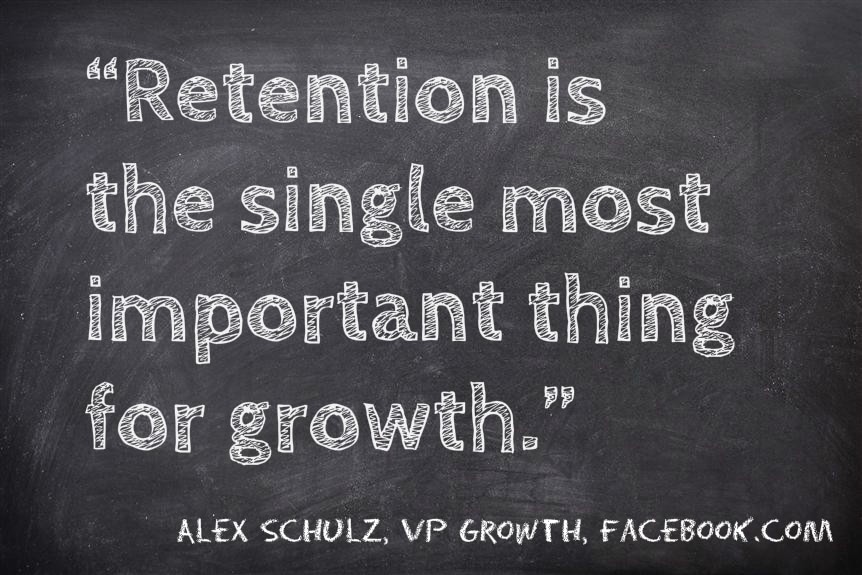
Not only is retention the super food for growth, it's also cheaper to keep your existing customers than to acquire new customers.
New Customers VS Existing Customers
According to KISSMetrics it can cost "7x more to acquire new customers" Think about that for a moment. “It costs 7 times more to acquire a customer than it does to retain one” and yet so many companies focus more on acquisition than customer retention.
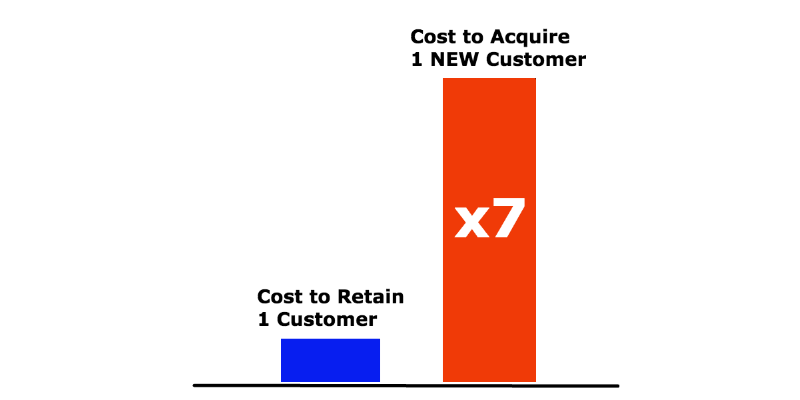
Given that fact, then love your existing customer, because it may be that customer retention is the single best use of your resources. (Maybe I should stop writing this post and go talk to some of our own customers?!)
Still not convinced? Then consider impact of customer retention on profits.
How Customer Retention impacts Profitability
If you are focused on profit, Customer Retention will boost your profits. According to research by Bain&Co, just a 5% improvement in your retention can boost your profits by anywhere from 25% to 125%.
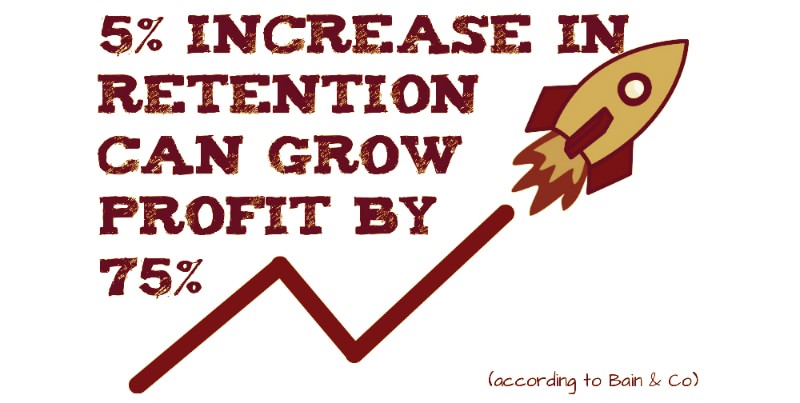
According to Bain & Co, an increase in retention of just 5% can lead to an increase profits by 75%
What Influences Customer Retention
Now I've convinced you of the importance of customer retention, what can you actually do about it?
There are many things you can do, and I'm going to outline five customer retention strategies, that you can use to think about improving your retention. Let's start with a new way of thinking: let's call it "Customer Retention Thinking".
Customer Retention Thinking
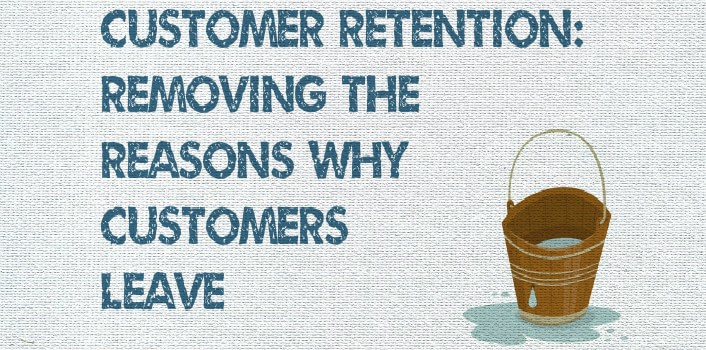
Customer Retention Thinking has one goal: to remove as many Reasons for Customers to Leave.
We're going to look at this whole subject of retention from the perspective of leaving customers, by asking ourselves the question "What makes my customers leave"?. Then we'll try to figure out what might be impeding our customer retention, and make some assumptions (guesses) and then test and measure those assumptions and see if they improve our customer retention.
Let's gets started.
First: Why Customers Leave.
Lincoln Murphy says "if your product sucks .. fix the product", and "if you attracted the wrong audience ..fix your marketing.".
Jason Cohen did a deep dive into customer cancellations at WordPress, and concluded there were 3 high level reasons a customer would cancel.
[Cancellation rate] = [product utility] + [service quality] + [acceptable price]
- Product - product meets customer needs successfully
- Price - an acceptable price (in your market)
- Service - how customers experience your service
I'll add another:
- Messaging - how you position your product in the minds of your customers
Obviously this list isn't exhaustive so here are a few more ideas to add more to your thinking.
Retention Strategy (1): Product Issues
Figure out if Product is impeding your retention.
Your Product has to work. Full-stop. It's a pre-requisite. It's entry stakes. And a great product doesn't guarantee success - in fact there are many cases where a superior product (with the wrong service, pricing or marketing) loses market share to an inferior product (with better service, pricing or marketing).
Great ways to figure out product problems are to do user trials. Sit down with users and watch where they get stuck, frustrated or confused. That's not about lack of features, it's about how the normal use of your product can differ from expectations or lead to a poor user experience. I can't think of anything better than sitting beside a customer and just observing where they have problems.
Another way to find blocks and obstacles is to do "remote user walkthroughs" via tools like mixpanel and KISSmetrics. Recently we sat down and replayed step-by-step each user visit as they used our product. We started to see patterns, where people would appear to get stuck, and realized that some of our app flow was confusing to customers and impeding our retention, so we redesigned to improve the flow.
Retention Strategy (2): Price Issues
Figure out if Pricing is impeding your retention.
Take a look at your market and competitor pricing. Where does your product sit in relation to others? Suppose you have a competitor at a much lower price that's targetting the same customers as you, you might want to think about what you can do with your pricing strategy. This is something you can test (with A/B experiments), plus could be something to ask customers who cancel ("was price the issue?").
Retention Strategy (3): Messaging Issues
Figure out if Messaging is impeding your retention.
How you message your product is important and non-trivial. Suppose your product is better than your competitors, so you can justify charging a higher price, or maybe you're targetting a different customer segment at a different price point. Maybe you need to change your messaging to differentiate from the lower priced competition? You could figure out if your messaging is impeding your retention by testing different messaging to find out what works best. (Tools like Optimizely, VWO and Google Analytics Experiments make this pretty easy. Plus you could also test different messaging using Google Adwords.)
Retention Strategy (4): Customer Experience
Figure out if customer experience is impeding your retention.
One way to measure customer experience is by using Net promoter Score. Net promoter Score is a tool that's used to gauge customer satisfaction by asking a single queston: "How likely is it that you would recommend our company/product/service to a friend or colleague?"
Net Promoter Score provides and overall measure of responses, and 50 or above is the magic number. According to Mailcloud, "if it’s higher than 50, your customer’s are telling their friends about you" which shows they are happy plus the word of mouth should generate more customers.
If your net promoter score is low that's a warning flag that customers aren't satisfied (and possibly saynig negative things to their friends/colleagues), a good signal that your customer service may be impeding your retention.
What else can you do with customer experience? One thing you can look at is your Customer Onboarding process. This is a part of your overall customer experience that can have a significant impact. It's a subject in its own right, so for now I'll leave you with this post on how to get your customer to the next milestone.
BONUS: If you want to add NPS to you site easily, you can use https://www.wootric.com/
BONUS: Here's a great case study of Groove.com using NPS.
Retention Strategy (5): Ask Customers why they Cancelled
Figure out WHY people are leaving.
Do this one thing today: contact every single customer that you've lost and simply ask them what caused them to cancel.
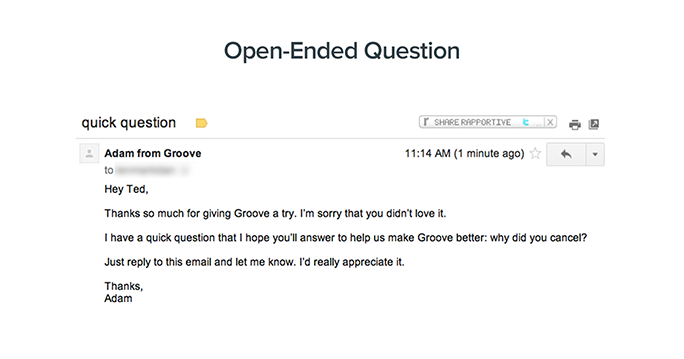
(IMAGE: groovehq.com)
Groove emailed their lost customers and got 10% response rate plus real actionable data, using the following email text:
Hey Ted,
Thanks so much for giving Groove a try. I'm sorry that you didn't love it.
I have a quick question that I hope you'll answer to help us make Groove better: what made you cancel?
Just reply to this email and let me know. I'd really appreciate it.
Thanks,
Adam
Lost customers are a treasure trove of insights to improve your retention.
Customer Retention: A Process
Here's a simple 5 step process to get you started with Customer Retention:
- STEP1: Start with the question: "WHY could my customers leaving?"
- STEP 2: Postulate some hypotheses, maybe you already have some ideas, and also apply the 5 strategies (below) to come up with other ideas.
- STEP 3: Prioritise which hypothesis you think may have the fastest or most significant impact, and then go test them AND MEASURE the results.
- STEP 4: Take what you've learned from your Hypothesis, figure out what's broken and then fix it.
- STEP 5: Go back to Step 1.
NOTE: Essential to the process is that you devise experiments to actually test and measure what works.
Measuring Your Success - Cohorts 101
Before you can improve your customer retention you need to know where you are today - and that means you need a way to measure your retention. Then you'll be able to see how your retention improves as you move forward. Welcome to Cohort Analysis.
"The cohort report is the single best tool for analyzing how customer behavior shifts over time." (Hiten Shah)
So, what’s a Cohort? And how is it helpful? A cohort is a group of people who share a common characteristic over a certain period of time. For example, all new Customers who signed up on 1st March have something in common: the same signup date.
Cohorts become interesting when you compare the difference between cohorts over time. For example, you could compare the 1st March cohort vs the 1st February cohort, to see has your retention improved. These comparisons are referred to as Cohort Analysis, and enable you to compare the behavior of different groups of customers.
Using a sign-up date is very common, as it allows you to see if customers who signed up more recently behave better on a given KPI (e.g. convert to a paid account, revisit 3x per week etc) than those who signed up earlier.
The idea is that, as you improve your Customer Retention, you will see an improvement in your Cohort Report for more recent cohorts.
It's best to use an automated Cohort Analysis tool like Mixpanel or KISSmetrics.
BONUS: Primer on Cohorts: Cohorts sound complicated, but really they arent. Here's a great primer from framed.io to get you started.
What next?
So now you know the importance of customer retention and you have a strategy to start improving your retention, it's time to get started.
Begin with Customer Retention Thinking, and identify for your specific situation what you think might be impeding your customer retention, and then start testing those assumptions to find out what improves your retention. Make sure you measure your current customer retention rate, and track how your business improves over time.
Was this post helpful? How do you improve your customer retention? Please let me know your thoughts in the comments section below.
 Popcorn Metrics
Popcorn Metrics